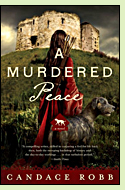A Murdered Peace
by Candace Robb
Reviewed by Margaret Tomlinson

The
heroine of A Murdered Peace is a young widow in medieval
York whose circumstances are complex enough that readers unfamiliar with the two
previous mysteries in this series may find the story hard to follow. To support
herself, Kate Clifford runs a guesthouse. She also rents a room by the night to
noblemen who need a discreet trysting place with their mistresses. Another of
her properties has become a religious house for beguines led by her mother. At home,
Kate is responsible for three children who are her wards.
The
story begins in the aftermath of the Epiphany Uprising, a rebellion against King
Henry IV during the winter of 1399-1400 by men who hoped to restore Richard II
to the throne. The rebellion was quickly squashed, its ringleaders beheaded, and
Richard imprisoned in Pontefract Castle, where he would die in February 1400.
Kate's
cook has disappeared, distressing her and her wards. Then, even more
distressingly, an old friend of hers arrives seeking a hiding place since her
husband has been killed by a mob for taking part in the uprising. If Lady
Margery is found, she too may be killed as a traitor, and Kate may be in danger
for sheltering her. The household's peril is deepened when a spice seller in
the city is murdered and Kate's cook is accused of the crime.
The complicated backstory does finally become clear enough, even for readers not previously introduced to it, for the tension over the apparently unrelated plights of the cook and Lady Margery to grow absorbing. And what about the attraction between Kate and the knight Sir Elric, who may or may not be trustworthy? Readers who enjoyed the previous Kate Clifford mysteries will want to read A Murdered Peace; those who haven't read them would do better to start at the beginning with The Service of the Dead instead of diving into the series with the third installment. (2018, 296 pages including an Author's Note regarding the Epiphany Rising)
More about A Murdered Peace at Powell's Books or The Book DepositoryOther mysteries and thrillers relating to the death of Richard II:
The Service of the Dead by Candace Robb (2016), about a young widow in late 14th-century York whose effort to free herself of the debts left by her husband is complicated when one of her guests is murdered; #1 in the Kate Clifford mystery series. More info.
A Burnable Book by Bruce Holsinger (2014), a thriller about a poet asked by Geoffrey Chaucer to find the manuscript of a book predicting the assassination of King Richard II; #1 in the John Gower series. More info
The Whyte Harte by P.C. Doherty (1988), about a thief in the employ of the Bishop of Beaufort who tries to help solve the mystery of how Richard II met his death while imprisoned in Pontefract Castle; #1 in the Matthew Jankyn mystery series. More info
Nonfiction about Richard II and Henry IV of England:
Richard II: A True King's Fall by Kathryn Warner (2018). More info
Henry IV (The English Monarchs Series) by Chris Given-Wilson (2016). More info
The Fears of Henry IV: The Life of England's Self-Made King by Ian Mortimer (2009). More info
Online:
The Epiphany Rising or 'Rebellion of the Earls' at The Yorkist Age website
Back to Medieval: 14th and 15th Centuries
Back to Directory of Book Reviews